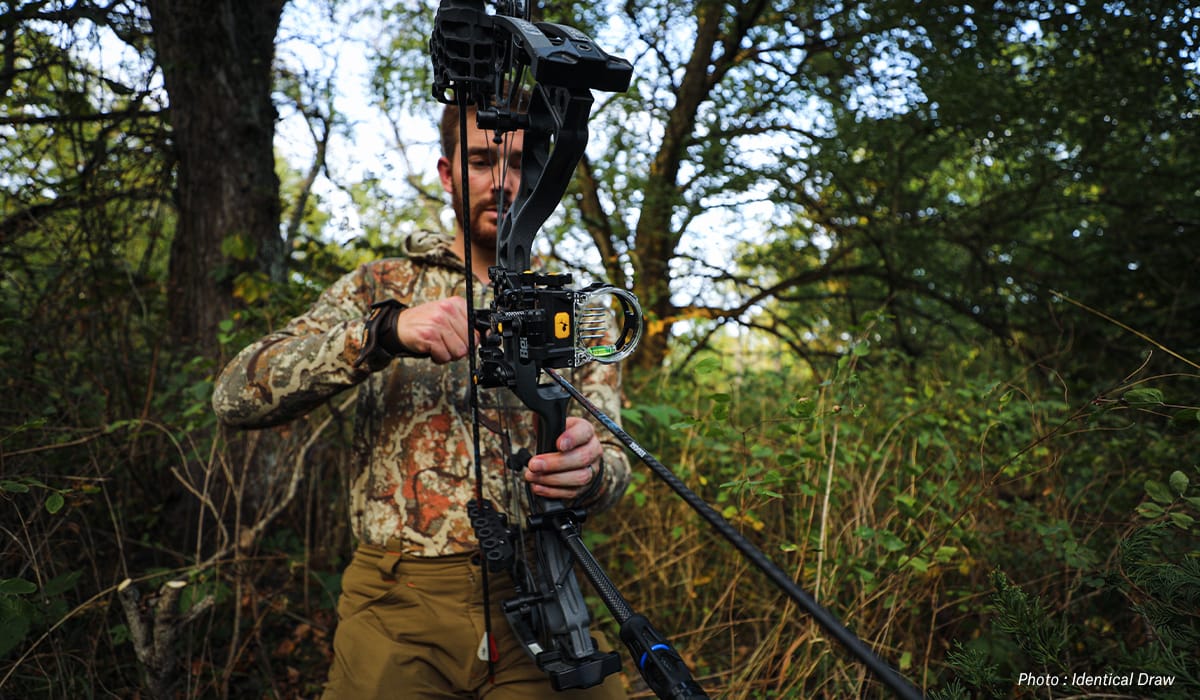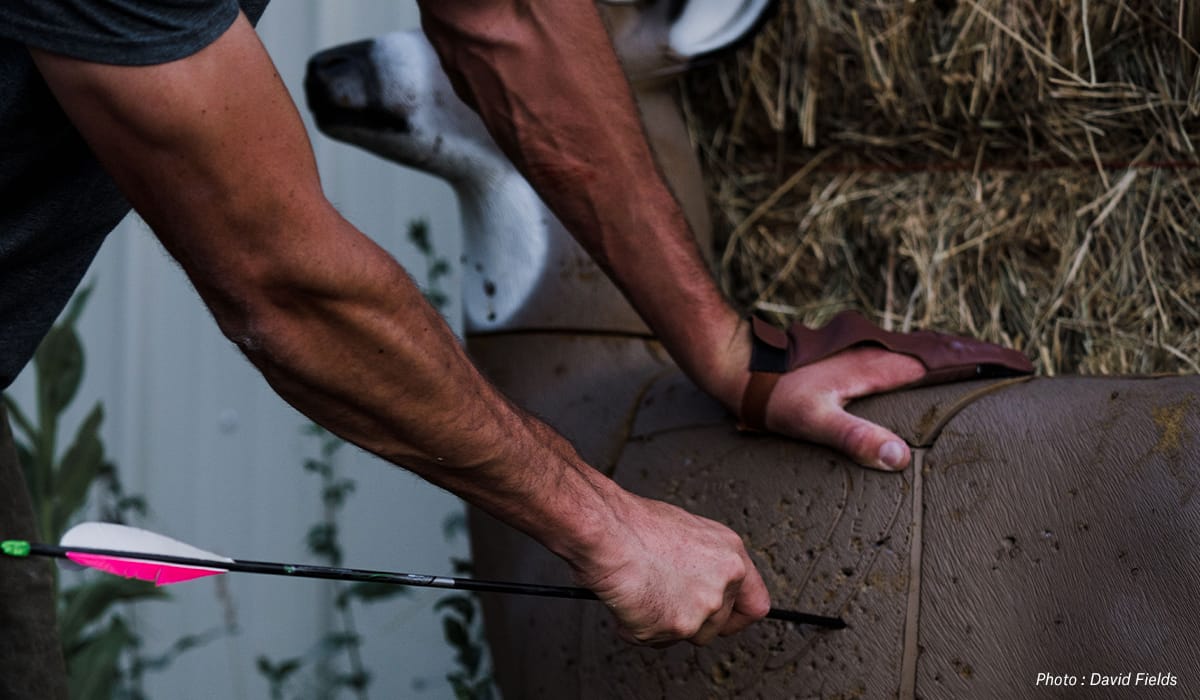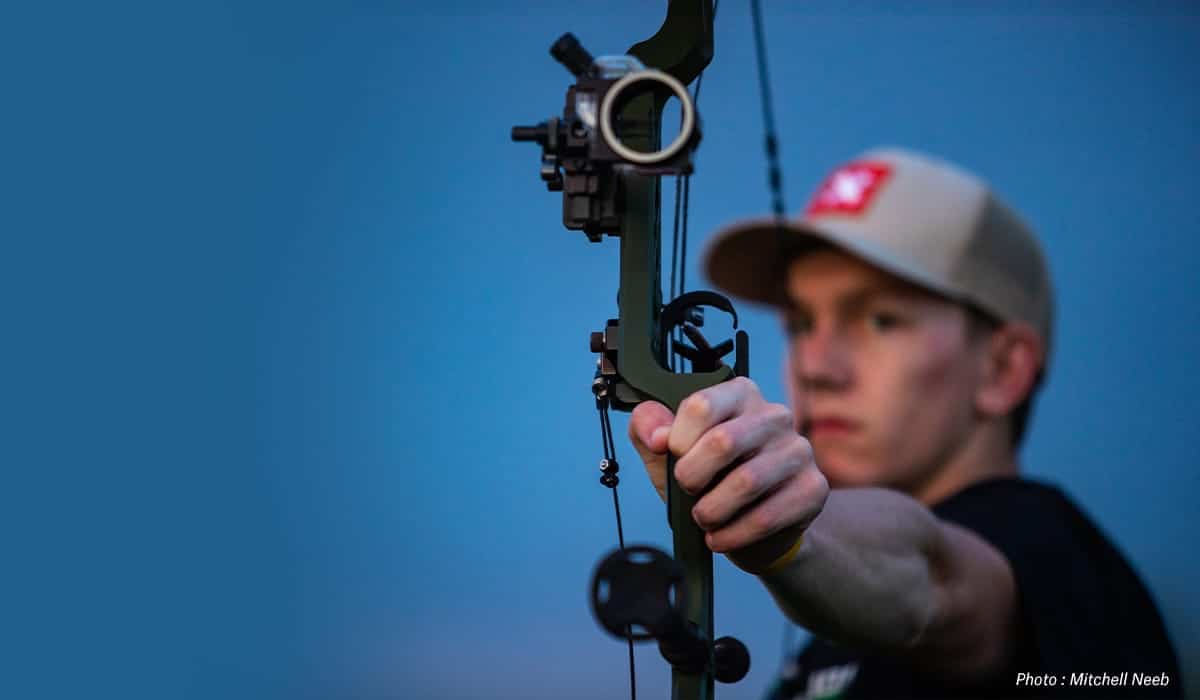Whether you’ve recently gotten a new bow or just upgraded your bow sight, you might be needing to dial in your bow so you’re ready for next season. Through these simple steps, you’ll be able to sight in a single-pin or multi-pin bow sight accurately and efficiently. That’ll give you the confidence to go full draw on the next season-opener.
First Steps To Sighting in a Bow
All the information about to be shared only works if the bow you’re sighting in is properly tuned and level. Much in the same way a rifle hunter wouldn’t sight a gun with a scope loosely attached, ensuring your bow is set up correctly is the first step of this sighting-in process.
This means your arrows nock in perfect alignment so they leave the arrow rest straight when released. Additionally, a tuned bow will have the sight attached to the bow as level as possible. If the sight is at all at an angle, your higher-yardage pins will send arrows left or right of your centerline, even if you have your 20-yard pin dialed. Working with your local archery shop is the best way to guarantee that your bow and bow sight are ready to fling arrows.
Next, you’ll need a space where you can safely shoot arrows at multiple distances if you’re sighting in a multi-pin sight (more on this shortly). Having an archery target, or targets, set at distances of 20, 30, and 40 yards is the minimum you’ll need to sight a bow properly. Some are lucky enough to use their own backyards for this; others may have access to indoor or outdoor archery ranges. Some, however, may need to scout for public land where shooting arrows is allowed (check with your local Fish, Wildlife, and Parks office to ask for recommendations).
Lastly, set aside a block of days you can work on sighting in your bow. Fatigue and wind (if outdoors) will affect your form and arrow flight. Getting in at least three different sessions shooting arrows will allow you to average your groups for each pin you’re sighting in. Ideally, none of your days shooting—at least for the sighting-in process—should be windy or rainy. You want perfect conditions so you know you’re sighting in as accurately as possible. Of course, you may want to practice in some of these weather conditions later as you get closer to bow season, but not at first.

Parts of the Bow Sight
Sights for compound bows are generally grouped as either a single-pin sight or multi-pin sight. Most modern, high-end bow sights will be equipped with multiple pins allowing a hunter to take shots from distances between 20 and 50+ yards, with pins set in 10-yard increments.
The most basic parts of a bow sight include the sight pins, often illuminated via colored fiber optic cables, and the round sight housing that contains all the pins. These two components are visually important and will be referenced more below. Some sights need specialized keys or Allen wrenches to adjust; some allow you to adjust by hand.
Before you begin the sighting process, space out the pins inside the housing so each has room to be adjusted up or down without crowding one other. Additionally, each pin can be adjusted left or right, so start with them aligned vertically in the middle of the housing.
Depending on your particular sight, you may also have a bubble level and a graduate windage scale that will aid you in keeping your bow straight and/or adjusting for varying in-field conditions.
One piece of equipment that is not technically part of your sight but is very helpful for shooting accurately is a peep sight. This is a small ring woven inside your bow string that, when at full draw, allows your dominant eye (generally right eye for right-handed shooters, and vice versa) to see “through” the string and line up the ring of the peep sight with the ring of the sight housing. This visually aids the shooter to 1) draw back to the same position every time and 2) know the bow is held as straight as possible. There are other alignment systems on the market, also called rear sights, but a peep sight is often the most practical and cost-effective. Ask your local archery technician what they recommend and have available.

Steps To Sighting in Your Bow
After you’ve considered or completed all the above steps, it’s time to start slinging some arrows. First, only sight in a new bow or a new sight with field-tipped arrows. Do not use broadheads; practicing with these will come later. Field tips are made to reduce wear on your target, be easier to remove from your target, and give your arrow its truest flight.
Assuming you’re working with a multi-pin sight, your top pin (the one furthest away from the ground at full draw) will be your closest distance pin. It’s recommended to sight this pin at 20 yards. Today’s high-speed bows don’t need to be sighted in for less than 20 yards as a general rule, but be sure to practice these close shots after you are sighted in.
The subsequent pins, below the top pin, are recommended to be sighted in at 30, 40, and 50 yards. Because those pins are below the top pin, bringing those pins to your target will cause you to aim your bow up in accordance with the arrow’s flight path. In simplest terms, since gravity is always working against you, if you want to shoot further you must aim higher so your arrow has a longer travel distance.

Starting at 20 yards with your top pin, loosen the screw that locks your horizontal adjustment of the sight housing (unless your archery technician did this alignment for you already). Knock an arrow, but do not draw. Slide the housing so the pins directly line up with both the string and the arrow. Now tighten the screw to lock in place.
Aim and take your first shot. Unless you’re way off the mark (ie. missed the target completely), take three or four more shots. If you are missing the target, move closer and shoot at 10 yards. Looking at the grouping of your arrows, were they high, low, left, or right of the bullseye? Whatever direction the arrows trended will tell you how to adjust the sight.
If you are off by eight or more inches, you’ll want to make your first adjustment to the housing, not the pins. This is the only time you’ll make adjustments to the housing. If you missed left, slide the housing left. If you missed right, move the housing so the pins move to the right. The same goes for missing up or down.
The #1 tip: Always follow the shot of your arrow when adjusting your sight. For example, miss left, move the pin left.
Now tighten the housing screws and take more shots. If you’re now shooting closer to the bullseye, less than six or so inches, you’ll start adjusting the individual top pin, not the housing. After a few more groups, making pin adjustments as needed, you can now move back to 30 yards and start aiming with the second pin from the top. If you have a single-pin sight, however, keep that pin sighted to 20 yards only and practice making aiming adjustments for closer or further shots.
If you moved your top pin, which now we’ll call your “20-yard pin,” much to the left or the right you can go ahead and adjust your 30-yard pin to be in line with the top pin. That should get your arrows at least in vertical alignment. Take several shots at 30 yards. If you’re missing, only adjust the pin to compensate. Do not move your housing anymore.
After you’re comfortable with your shots at 20 and 30 yards, it’s recommended you take a break at least for a day before setting your remaining pins for 40 or 50+ yards. When you come back the next day, shoot at 20 yards, then at 30 yards, to make sure your form is still good and your aim is true. You can make tweaks to your pins if needed, and then you follow all the steps above to shoot at the distances for however many pins you have left on your sight.
On the third day of shooting, it’s really just shooting through all your pin distances to make sure nothing is much amiss. One good tactic is to shoot three arrows at each distance, but shoot at all distances before making any adjustments. If all your arrows, for instance, were shooting low and left, maybe something was off in your form, or your sight got knocked.
Hopefully with all these fairly simple steps your new bow or bow sight will be dialed and your groups will be tight. Happy hunting.
~~~
Sight in Your New Bow
This simple guide to sighting in your bow outlines all the above-mentioned steps. Remember, always follow your arrow. If you miss left, move the sight pin left to bring your next shot toward the center of the target.
Start with the top pin.
Sight your top pin first. Typically, the top pin should hit a bullseye at 20 yards. The pins below the top pin are usually sighted in at 30, 40, and 50+ yards, respectively.
Align the sight housing.
Loosen the horizontal adjustment screw on the sight and slide the housing so the pins directly line up with both the string and the arrow. Now tighten the screw to lock in place.
Shoot at least three arrows.
If you consistently missed the bullseye by eight or more inches, loosen and slide the housing in the direction your arrows missed. Take three more shots. If you’re missing by less than eight inches you can start adjusting the top pin to tighten your aim. Like before, move the pin in the direction you miss the target. If you shot to the right, move your pin to the right.
Sight the 30-yard pin.
After you’ve sighted in the top pin to 20 yards, move down to the next pin and shoot from 30 yards. Follow the instructions in Step 3, with one exception. Do not make any adjustments to the housing after your top pin has been sighted. Only adjust the individual pins from here on out.
Take a break. Then sight your long-distance pins.
Taking a short break (at least 24 hours) will let your body recover from any shooting fatigue and ensure you have excellent form when shooting at longer distances. You can now follow Step 4 again to sight in your 40 and 50+ yard pins.
Shoot three-arrow groups at all distances.
Lastly, and after another 24-hour break, come back to the range or your backyard target and shoot three-arrow groups at every distance. Looking at how your arrows group will let you know if you need to fine-tune anything.